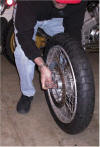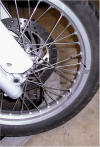F650 Wheel Balancing FAQ
edited by Kristian #562
Please read the Disclaimer before
attempting any work in this FAQ.
Last Updated: 16 June 2006, by Winter #1935
Home Tire Balancing
by Harl #380, January 21, 2000
This procedure describes balancing the tires for your F650 at home. It
is pretty universal, but won't work for certain types of rims, notably
BMW/Triumph/Ducati/Honda rears from bikes with single sided swingarms.
However, it'll work for just about everything else. It's a good idea to
read the entire article to familiarize yourself with what's going on. Like
most tasks you'll get better with experience. If you're not comfortable
with the procedure or your abilities, take your wheel to a shop and have
them do it. The author and publisher accept no responsibility for
improperly balanced wheels or ensuing problems they might cause. Properly
followed, the procedure will give you a good tire balance without any
expensive equipment.
Stuff you'll need
- Freshly mounted tire and wheel.
- Long 3/8" extension - A foot or so is great. You can use
your axle, but an extension or some similar smooth rod smaller than the
axle works better.
- Tape weights - Save your old ones for the initial balance. For new
ones, your BMW dealer will sell you the trick tape weights with the logo,
but they are pretty pricey. Most shops will sell you a generic strip,
usually segmented in 1/4 oz increments, for a couple of bucks. You can
use spoke type weights, but they are not as easy to use and get a good
balance.
- Wire cutters to cut the weights
- Duct or masking tape (duct works better)
- Light colored crayon, wax pencil, or chalk
- Spray carb cleaner and rag or similar
Getting to it
Some folks don't feel the need to balance tires for "dirt
bikes." That's great, if you're talking about something like a purely
off road vehicle. However, most F650s spend most of their lives on the
road, and an imbalanced tire at even 55 miles can be uncomfortable and
even dangerous. You probably want to change your own tires and balance
them to save a bit of money, but sometimes just doing it yourself is
enough of a motivating factor.
We'll start at the point where you have the worst part of the job
behind you, the new tire is on the rim.
Make sure all the old weights are off the rim.
- Slip your balancing tool through the wheel.
- Sit on a stool (or bend your knees and squat) and pick up the
wheel, supporting your elbows on your knees.

- It's important to keep the wheel and tire as vertical as possible.
The picture shows the squat method.
- "Rock" the extension gently in your hands so that the
extension rolls back and forth in the wheel bearings.
- You don't have to rock very hard, just enough to make the wheel
move. The motion causes the wheel to "roll" on the extension.
The heaviest point on the wheel will migrate to the bottom of the wheel's
travel. It'll roll back and forth a few times on the extension until it
finally stops.
- Mark the very top of the tire with a crayon or chalk.
This is the lightest place on the tire/wheel assembly.
- Clean a flat section of the rim with the carb or other cleaner
adjacent to the mark on the tire.
- This provides a good clean mounting surface for the tape on the
weights.
- Take one of your old weights, or cut a new piece about 1.5 oz, and
tape to the clean spot on the rim with a small piece of duct tape.
If you're using new weights, don't pull the backing off the weight just yet!
- Resume your squat/sit with the tire, placing the taped weight at
the 3 o'clock position.
- Rock the axle again.
- The wheel will probably move again. If the weight moves toward the
bottom of the wheel's motion, the weight is too big. If it moves to the
top, it's too small. Proceed to the next step. If it doesn't move or moves
very very slowly, run immediately to the nearest Lottery outlet and buy
some tickets, then skip to Step 10.
- Adjust the amount of weight you tape to the rim and repeat
This is a trial and error approach that you'll be better at with
experience. You'll learn to estimate how much to change the weight. If the
tire moves slowly don't change the weight much, more if it moves quickly.
Note: If the required weight is more than four ounces, deflate the tire,
break the bead loose, move the tire 180 degrees on the rim, re-inflate,
and return to your tire/wheel assembly is seriously out of balance. Moving
the tire may help. Did you line up the balance mark when you mounted the
tire?
- Cut a piece of new tape weight the same weight as the used piece
(or peel the backing of the new weight you're using) and put it on the rim.
- Mount the weight as shown in the picture. An improperly mounted
weight could be pulled off by centrifugal force, making it more like a
bullet...

- You're done! Remount the wheel, using all the proper torque
specs, and go for a nice smooth ride!
CBOA Wheel Balancer
Ok, I've checked out all the commercial offerings in wheel balancing,
and I'm wondering if there isn't an easier way. My idea is a thin cable,
suspended from the ceiling through the center of the wheel. Not sure what
I'd use to center the cable in the wheel yet, but probably something
similar to the "universal" type cones they are using on the horizontal
balancers.
So, with the help of my buddy gravity, the heavy part of the wheel
droops floorwards. Stickum weight to counter the droop, and the wheel is
static balanced... right? Anybody ever tried something silly like this?
Will it work? Problems? Ideas? Suggestions?
I've got some ideas for making the actual use easier than trying to
string a single piece of cable through the wheel and then hanging it up,
but am just trying to validate the concept at the moment. dmemt
#1464
- Use the horizontal ones. The rig you're talking about will have
you chasing your tail for hours. You will not be able to hook it to the
center of the wheel as this would be in the middle of the hub. Jetdoc,
#1546
- I have a simple balancer that I dreamed up. I can't link to a
photo here, so I sent you one via email. Mark J #1495
- I have a friend who wrenches for a living and that's how he
balances his wheels. Besides, if you always use the same brand/type of
tire and put the lil' dot in the right spot every time you put on new
tires, chances are you won't need to rebalance the wheel. I've put on
several different types of tires and have yet had to remove or add any
weights and I have one of them fancy schmancy over-priced wheel balancer
thingies. Shank
Feedback
- All you need to balance your wheels (besides the weights) is a
piece of bar that is about the same size as the axles, and two jack
stands. since the f650 uses sealed bearings, not tapered roller bearings,
you don't need anything on the outside of the wheel. You MAY even be able
to simply use the axles on jackstands. I happen to have the bar, which is
part of my tire changer, but as long as the axles are long enough (and I
think they are), they would of course be the perfect diameter. Mark
#403.

